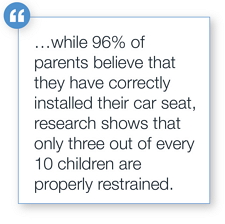Parents need
to do a better job of buckling in their children.
It’s been three decades since the use of child
safety seats became law in the United States. And while most parents understand
the importance of these safety devices, recent inspections conducted in New
York State indicate that guidance is still needed on how to properly use them.
In a series of recent state-run safety checks, only
112 of 931 car seats inspected, or about 12 percent, were installed correctly[1].
The most common mistakes included using the wrong seat for the child’s size and
age, not positioning the seat correctly, and not securing or tightening the
seat’s harness and crotch straps.
These mistakes can literally be fatal, as the National
Highway Traffic Safety Administration (NHTSA)[2]
reports that properly installed child safety seats reduce the risk of death by
71 percent for infants younger than 1 year old and by 54 percent for toddlers ages 1 to 4
years. The NHTSA also reports that while 96 percent
of parents believe that they have correctly installed their car seat, research
shows that only three out of every 10 children are properly restrained.
Steps
to proper installation
So, what can you do to make sure you are using your
car seat correctly? In addition to choosing a seat that properly fits your
vehicle and carefully reading and following the manufacturer’s instructions,
Safe Kids Worldwide
offers these tips for car seat installation:
- Check the label on your car seat to make
sure it is age- and size-appropriate for your child.
- Always place a car seat in the backseat
of a vehicle. Children should remain in the backseat until age 13.
- Keep children in rear-facing car seats
as long as possible – at least until age one, before moving them to a
forward-facing seat.
- Once you have installed the car seat,
give it a shake from its base. A properly-installed car seat shouldn’t move
more than one inch in any direction.
- After placing the harness around your child,
make sure that it is tight and that the straps are coming through the proper
slots. The harness is tight enough and the chest clip properly placed if you cannot
pinch any extra webbing at your child’s shoulder.
For added assurance, parents can discuss and examine
their installation with a certified technician at a car seat inspection
station. Most communities host such stations periodically at places such as car
dealerships or store parking lots.
To find a station near you, you can check the
websites SeatCheck.org, or call your local police or fire department’s
non-emergency number, local hospital or highway safety office.
Moving
beyond the car seat
Once a child graduates from a car seat, the proper
use of safety devices remains important, as motor vehicle injuries are a
leading cause of death for children in the United States and Canada.
Using a booster seat until a seat belt properly fits
a child reduces the risk of serious injury by as much as 45 percent, according to the
Centers for Disease Control and Prevention[3].
Booster seats work by raising your child so that the shoulder belt fits
properly across the hips and chest.
A properly fitting belt rests on the upper thighs
and chest, not the belly and neck. It is recommended that children use a
booster seat from age 4 to 8, or until they reach a height of 57 inches. For
older children and adults, the use of a seat belt cuts the risk of serious
injury in half.
In the case of motor vehicle accidents, an ounce of
prevention is worth far more than a pound of cure. Contact your HUB Representative to learn more.
[1] N.Y. Inspections Reveal Many Parents Flunk Child Car Seat Safety Checks, Insurance Journal 2015
[2] Car Seat Recommendations for Children, NHTSA
[3] Injury Prevention & Control: Motor Vehicle Safety, Centers for Disease Control and Prevention